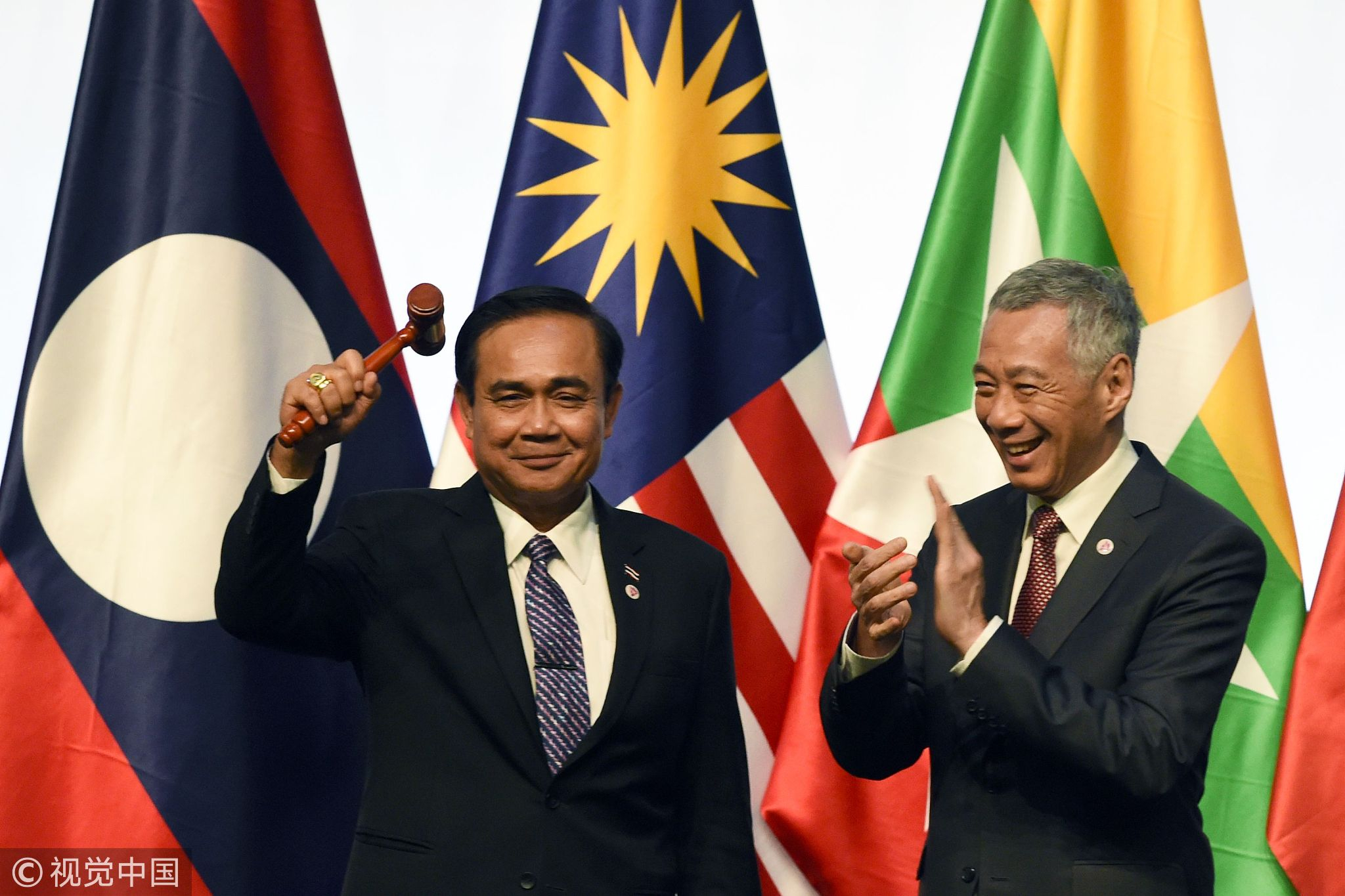
Opinions
20:44, 16-Nov-2018
Opinion: ASEAN vital for East Asia’s regional integration
Updated
20:26, 19-Nov-2018
Song Qingrun

Editor's note: Song Qingrun is an associate professor (PhD) at the China Institutes of Contemporary International Relations. The article reflects the authors' opinion, and not necessarily the views of CGTN.
November 13 to 15 this year was the "Summit Season" for ASEAN, and Singapore, as this year's Chair of ASEAN, has attracted the world's attention.
A series of summits were held there, including the ASEAN Summit, three ASEAN+1 Summits (ASEAN + China, Japan and South Korea respectively), and ASEAN+3 Summit (ASEAN + China, Japan and South Korea), East Asia Summit (ASEAN plus 8 dialogue partners including US, China, Japan, Russia, India, Australia, etc.), and the second Regional Comprehensive Economic Partnership (RCEP) leaders' meeting.
The number and the level of the summits held are unmatched in the world, which shows that ASEAN plays an irreplaceable role in regional integration and cooperation in East Asia.
I believe that ASEAN has created at least two miracles in regional cooperation and integration. One miracle is that, it has established a regional integration and cooperation network with ASEAN at the center. Just as mentioned above, ASEAN has established a number of summit mechanisms.
Moreover, it has also established multiple ministerial-level and senior official-level dialogue mechanisms, such as the ASEAN Regional Forum, the ASEAN Defense Ministers' Meeting. The role that ASEAN plays in promoting regional cooperation ranks only second to the EU.

US Vice President Mike Pence (R), his wife Karen Pence (2nd-R) are presented with an orchid named after them by Singaporean Prime Minister Lee Hsien Loong (2nd-L), and his wife Ho Ching at the Presidential Palace in Singapore on November 16, 2018. /VCG Photo
US Vice President Mike Pence (R), his wife Karen Pence (2nd-R) are presented with an orchid named after them by Singaporean Prime Minister Lee Hsien Loong (2nd-L), and his wife Ho Ching at the Presidential Palace in Singapore on November 16, 2018. /VCG Photo
Another miracle ASEAN has brought about is that the main big powers in the world have carried out good cooperation with ASEAN.
The US, ASEAN's eight dialogue partner countries and leaders from important international organizations attend every year's ASEAN summit and related meetings. If any other big country wants to replace ASEAN as the leader of East Asia's regional integration and cooperation, it will most likely fail.
It is because big powers that have a stake in the region, such as the US, China, Russia, Japan, India, and South Korea, have very complicated relations with each other whereas ASEAN generally has good relations with all of them, and poses no threats to any of them.
If we compare the EU with ASEAN, the former is a highly integrated bloc where the two big powers, namely France and Germany, always play a leading role in the union's integration process, while ASEAN is a relatively loose regional organization and formed mainly by middle-sized and small countries, except Indonesia, which is the biggest country is the region. Even so, ASEAN can lead East Asia's regional integration and cooperation process and make great achievements.
I also want to emphasize that ASEAN plays an important role in pushing for a multilateral trade bloc in Asia. All of the summits held in Singapore this week were very important; however, there was one of particular significance, which was the second RCEP leaders' meeting, attended by leaders from ASEAN's 10 member states and its six dialogue partners (China, Japan, South Korea, India, Australia, New Zealand).

Singapore's Prime Minister Lee Hsien Loong (R) applauds as Thai Prime Minister Prayut Chan-O-Cha holds up the gavel during the closing ceremony of the 33rd Association of Southeast Asian Nations (ASEAN) summit in Singapore on November 15, 2018. /VCG Photo
Singapore's Prime Minister Lee Hsien Loong (R) applauds as Thai Prime Minister Prayut Chan-O-Cha holds up the gavel during the closing ceremony of the 33rd Association of Southeast Asian Nations (ASEAN) summit in Singapore on November 15, 2018. /VCG Photo
ASEAN plays an important role in coordinating 16 countries to reach a final deal. All leaders have agreed that they will make joint efforts to overcome difficulties, and try to finish the negotiation process next year. The consensus on concluding negotiations as soon as possible is important as reaching the final agreement on RCEP has been postponed for several times in the past years.
RCEP will be an FTA bloc based on WTO rules, and the bloc will account for about half of the world population and one third of world trade. This possible FTA bloc will protect regional and world trade system, and make Asia an important engine of the world trade growth.
However, ASEAN also faces challenges. For example, its ability falls short of its ambitions at times. As ASEAN has to work with more countries and organizations, how to coordinate different interests between them has been a challenge. Moreover, some big powers attempt to dominate certain regional issues, such as regional security, and some of them have slowed down the process of ASEAN-led regional cooperation. Last but not least, the current trade protectionist trend poses threats to the free trade in Asia.
That being said, challenges should not diminish our confidence in ASEAN. Given the achievements ASEAN has made in the past and the support it has been able to galvanize from big powers in the region in pressing ahead with regional integration, there is no doubt that ASEAN's role will only be strengthened in the future.
(Cover: Singapore's Prime Minister Lee Hsien Loong speaks during a press conference at the end of the 33rd Association of Southeast Asian Nations (ASEAN) summit in Singapore on November 15, 2018. /VCG Photo)
(If you want to contribute and have specific expertise, contact us at opinions@cgtn.com)

SITEMAP
Copyright © 2018 CGTN. Beijing ICP prepared NO.16065310-3
Copyright © 2018 CGTN. Beijing ICP prepared NO.16065310-3